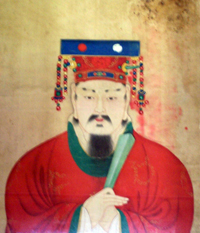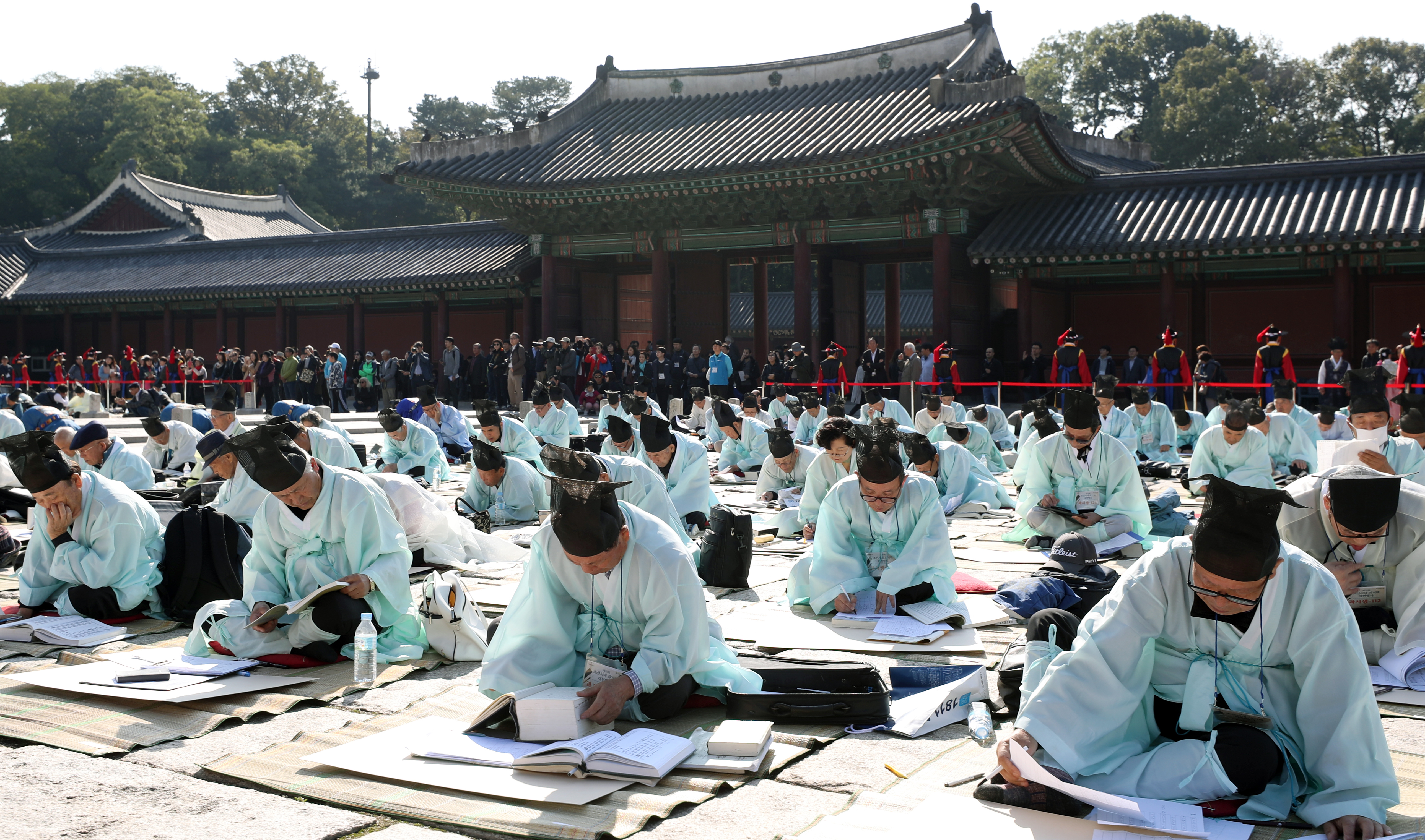|
Gim Myeong-hui
Gim Myeong-hui (1788-?), also known as Kim Myeong-hui, was a calligrapher of the late Joseon Dynasty. He was born into a yangban family of the Gyeongju Gim lineage, the son of Gim No-gyeong. He passed the ''jinsa'' literary examination in 1810, and entered government service. However, he never rose above the rank of hyeon magistrate. Accompanying his father on a mission to the Qing Dynasty court in 1822, he struck up correspondences with leading Chinese calligraphers of the time, including Liu Xihai ( :zh:劉喜海). Gim's elder brother Gim Jeong-hui was also known for his calligraphy.Lee (1993), p. 124. Notes References * * See also *Korean culture *Joseon Dynasty *Korean calligraphy Korean calligraphy, also known as Seoye (), is the Korean tradition of artistic writing. Calligraphy in Korean culture involves both Hanja (Chinese logograph) and Hangul (Korean native alphabet). Early Korean calligraphy was exclusively in Ha ... {{DEFAULTSORT:Gim, Myeong Hui 19th- ... [...More Info...] [...Related Items...] OR: [Wikipedia] [Google] [Baidu] |
Kim (Korean Name)
Kim or KIM may refer to: Names * Kim (given name) * Kim (surname) ** Kim (Korean surname) *** Kim family (other), several dynasties **** Kim family (North Korea), the rulers of North Korea since Kim Il-sung in 1948 ** Kim, Vietnamese form of Jin (Chinese surname) Languages * Kim language, a language of Chad * Kim language (Sierra Leone), a language of Sierra Leone * kim, the ISO 639 code of the Tofa language of Russia Media * ''Kim'' (album), a 2009 album by Kim Fransson * "Kim" (song), 2000 song by Eminem * "Kim", a song by Tkay Maidza, 2021 * ''Kim'' (novel), by Rudyard Kipling ** ''Kim'' (1950 film), an American adventure film based on the novel ** ''Kim'' (1984 film), a British film based on the novel * "Kim" (''M*A*S*H''), a 1973 episode of the American television show ''M*A*S*H'' * ''Kim'' (magazine), defunct Turkish women's magazine (1992–1999) Organizations * Kenya Independence Movement, a defunct political party in Kenya * Khalifa Islamiyah Mindana ... [...More Info...] [...Related Items...] OR: [Wikipedia] [Google] [Baidu] |
Korean Calligraphy
Korean calligraphy, also known as Seoye (), is the Korean tradition of artistic writing. Calligraphy in Korean culture involves both Hanja (Chinese logograph) and Hangul (Korean native alphabet). Early Korean calligraphy was exclusively in Hanja, or the Chinese-based logography first used to write the Korean language. During the Goryeo and Joseon dynasties, utilitarian objects were often inscribed with calligraphy such as brush stands, padlocks, incense burners, porcelain, lacquer, and branding irons. Even after the invention of the Korean alphabet Hangul in 1443, Korean calligraphers preferred Chinese characters as they saw it as more prestigious. Hanja continued to be used as the official script until the late 19th century. This changed when both North Korea and South Korea, after their split, separately institutionalized Hangul as the official orthography of Korean. Today many calligraphers, particularly in South Korea, are experimenting with new styles of Hangul, which has ... [...More Info...] [...Related Items...] OR: [Wikipedia] [Google] [Baidu] |
Joseon Dynasty
Joseon (; ; Middle Korean: 됴ᇢ〯션〮 Dyǒw syéon or 됴ᇢ〯션〯 Dyǒw syěon), officially the Great Joseon (; ), was the last dynastic kingdom of Korea, lasting just over 500 years. It was founded by Yi Seong-gye in July 1392 and replaced by the Korean Empire in October 1897. The kingdom was founded following the aftermath of the overthrow of Goryeo in what is today the city of Kaesong. Early on, Korea was retitled and the capital was relocated to modern-day Seoul. The kingdom's northernmost borders were expanded to the natural boundaries at the rivers of Amrok and Tuman through the subjugation of the Jurchens. During its 500-year duration, Joseon encouraged the entrenchment of Confucian ideals and doctrines in Korean society. Neo-Confucianism was installed as the new state's ideology. Buddhism was accordingly discouraged, and occasionally the practitioners faced persecutions. Joseon consolidated its effective rule over the territory of current Korea and saw the ... [...More Info...] [...Related Items...] OR: [Wikipedia] [Google] [Baidu] |
Yangban
The ''yangban'' () were part of the traditional ruling class or gentry of dynastic Korea during the Joseon Dynasty. The ''yangban'' were mainly composed of highly educated civil servants and military officers—landed or unlanded aristocrats who individually exemplified the Korean Confucian form of a " scholarly official". They were largely government administrators and bureaucrats who oversaw medieval and early modern Korea's traditional agrarian bureaucracy until the end of the dynasty in 1897. In a broader sense, an office holder's family and descendants, as well as country families who claimed such descent, were socially accepted as ''yangban''. Overview Unlike noble titles in the European and Japanese aristocracies, which were conferred on a hereditary basis, the bureaucratic position of ''yangban'' was granted by law to ''yangban'' who meritoriously passed state-sponsored civil service exams called ''gwageo'' (). This exam was modeled on the imperial examinations first s ... [...More Info...] [...Related Items...] OR: [Wikipedia] [Google] [Baidu] |
Gyeongju Gim
Gyeongju ( ko, 경주, ), historically known as ''Seorabeol'' ( ko, 서라벌, ), is a coastal city in the far southeastern corner of North Gyeongsang Province in South Korea. It is the second largest city by area in the province after Andong, covering with a population of 264,091 people (as of December 2012.) Gyeongju is southeast of Seoul, and east of Daegu. The city borders Cheongdo and Yeongcheon to the west, Ulsan to the south and Pohang to the north, while to the east lies the coast of the Sea of Japan. Numerous low mountains—outliers of the Taebaek range—are scattered around the city. Gyeongju was the capital of the ancient kingdom of Silla (57 BC – 935 AD), which ruled about two-thirds of the Korean Peninsula at its height between the 7th and 9th centuries, for close to one thousand years. Later Silla was a prosperous and wealthy country, and its metropolitan capital of Gyeongju was the fourth largest city in the world. A vast number of archaeological sites and ... [...More Info...] [...Related Items...] OR: [Wikipedia] [Google] [Baidu] |
Gwageo
The ''gwageo'' or ''kwago'' were the national civil service examinations under the Goryeo and Joseon dynasties of Korea. Typically quite demanding, these tests measured candidates' ability of writing composition and knowledge of the Chinese classics. The form of writing varied from literature to proposals on management of the state. Technical subjects were also tested to appoint experts on medicine, interpretation, accounting, law etc. These were the primary route for most people to achieve positions in the bureaucracy. Based on the civil service examinations of imperial China, the ''gwageo'' first arose in Unified Silla, gained importance in Goryeo, and were the centerpiece of most education in the Joseon dynasty. The tutelage provided at the hyanggyo, seowon, and Sungkyunkwan was aimed primarily at preparing students for the gwageo and their subsequent career in government service. Under Joseon law, high office was closed to those who were not children of officials of the s ... [...More Info...] [...Related Items...] OR: [Wikipedia] [Google] [Baidu] |
Hyeon
Korea's provinces ('' Do''; hangul: 도; hanja: ) have been the primary administrative division of Korea since the mid Goryeo dynasty in the early 11th century, and were preceded by provincial-level divisions (''Ju'' and ''Mok'') dating back to Unified Silla, in the late 7th century. During the Unified Silla Period (AD 668–935), Korea was divided into nine ''Ju'' (주; ), an old word for "province" that was used to name both the kingdom's provinces and its provincial capitals. After Goryeo defeated Silla and Later Baekje in 935 and 936 respectively, the new kingdom "was divided into one royal district (''Ginae;'' 기내; ) and twelve administrative districts (''Mok;'' 목; )" ( Nahm 1988), which were soon redivided into ten provinces (''Do''). In 1009 the country was again redivided, this time into one royal district, five provinces (''Do'') and two frontier districts (''Gye;'' 계; ?). After the Joseon dynasty's rise to power and the formation of Joseon in 1392, the country ... [...More Info...] [...Related Items...] OR: [Wikipedia] [Google] [Baidu] |
Qing Dynasty
The Qing dynasty ( ), officially the Great Qing,, was a Manchu-led imperial dynasty of China and the last orthodox dynasty in Chinese history. It emerged from the Later Jin dynasty founded by the Jianzhou Jurchens, a Tungusic-speaking ethnic group who unified other Jurchen tribes to form a new "Manchu" ethnic identity. The dynasty was officially proclaimed in 1636 in Manchuria (modern-day Northeast China and Outer Manchuria). It seized control of Beijing in 1644, then later expanded its rule over the whole of China proper and Taiwan, and finally expanded into Inner Asia. The dynasty lasted until 1912 when it was overthrown in the Xinhai Revolution. In orthodox Chinese historiography, the Qing dynasty was preceded by the Ming dynasty and succeeded by the Republic of China. The multiethnic Qing dynasty lasted for almost three centuries and assembled the territorial base for modern China. It was the largest imperial dynasty in the history of China and in 1790 the f ... [...More Info...] [...Related Items...] OR: [Wikipedia] [Google] [Baidu] |
Liu Xihai
/ ( or ) is an East Asian surname. pinyin: in Mandarin Chinese, in Cantonese. It is the family name of the Han dynasty emperors. The character originally meant 'kill', but is now used only as a surname. It is listed 252nd in the classic text Hundred Family Surnames. Today, it is the 4th most common surname in Mainland China as well as one of the most common surnames in the world. Distribution In 2019 劉 was the fourth most common surname in Mainland China. Additionally, it was the most common surname in Jiangxi province. In 2013 it was found to be the 5th most common surname, shared by 67,700,000 people or 5.1% of the population, with the province with the most people being Shandong.中国四百大姓, 袁义达, 邱家儒, Beijing Book Co. Inc., 1 January 2013 Origin One source is that they descend from the Qí (祁) clan of Emperor Yao. For example the founding emperor of the Han dynasty (one of China's golden ages), Liu Bang (Emperor Gaozu of Han) was a descendant of E ... [...More Info...] [...Related Items...] OR: [Wikipedia] [Google] [Baidu] |
Gim Jeong-hui
Gim Jeong-hui (김정희, 金正喜, born on the 3rd day of the 6th lunar month 1786, died on the 10th day of the 10th lunar month 1856), also known as Kim Jeong-hui, was one of the most celebrated practitioners of calligraphy, epigraphists, and scholars of Korea’s later Joseon period. He was a member of the Gyeongju Gim clan. He used various Ho (pen-names): Wandang (阮堂), Chusa (秋史), Yedang (禮堂), Siam (詩庵), Gwapa (果坡), Nogwa (老果) etc. (some 200 in all). He is especially celebrated for having transformed Korean epigraphy and for having created the “Chusa-che” (秋史體 Chusa writing style) inspired by his study of ancient Korean and Chinese epitaphs. His ink paintings, especially of orchids, are equally admired. As a scholar, he belonged to the Silhak (Practical Learning) school also known as the Bukhak (北學, “Northern Learning”). He was related to Queen Jeongsun, the second wife of King Yeongjo, and by his adoptive mother, Nam Yang-hong ... [...More Info...] [...Related Items...] OR: [Wikipedia] [Google] [Baidu] |


